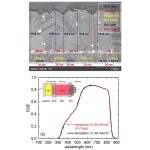 “Through-the-glass spectroscopic ellipsometry for analysis of CdTe thin-film solar cells in the superstrate configuration”, P. Koirala1, J. Li, H. P. Yoon, P. Aryal, S. Marsillac, A. A. Rockett, N. J. Podraza and R. W. Collins, Progress in Photovoltaics 24, 1055, 2016.
“Through-the-glass spectroscopic ellipsometry for analysis of CdTe thin-film solar cells in the superstrate configuration”, P. Koirala1, J. Li, H. P. Yoon, P. Aryal, S. Marsillac, A. A. Rockett, N. J. Podraza and R. W. Collins, Progress in Photovoltaics 24, 1055, 2016.
1. Department of Physics & Astronomy and Wright Center for Photovoltaics Innovation & Commercialization, University of Toledo, Toledo, OH 43606, USA; 2. Center for Nanoscale Science and Technology, National Institute of Standards and Technology, Gaithersburg, MD 20899, USA; 3. Maryland Nanocenter, University of Maryland, College Park, MD 20742; 4. Virginia Institute of Photovoltaics, Old Dominion University, Norfolk, VA 23529, USA; 5. Department of Materials Science and Engineering, University of Illinois at Urbana-Champaign, Urbana, IL 61801, USA.
ABSTRACT. Polycrystalline CdS/CdTe thin-film solar cells in the superstrate configuration have been studied by spectroscopic ellipsometry (SE) using glass side illumination. In this measurement method, the first reflection from the ambient/glass interface is rejected, whereas the second reflection from the glass/film-stack interface is collected; higher order reflections are also rejected. The SE analysis incorporates parameterized dielectric functions ε for solar cell component materials obtained by in situ and variable angle SE. In the SE analysis of the complete cells, a step-wise procedure ranks the fitting parameters, including thicknesses and those defining the spectra in ε, according to their ability to reduce the root-mean-square deviation between the simulated and measured SE spectra. The best fit thicknesses from this analysis are found to be consistent with electron microscopy. Based on the SE results, the solar cell quantum efficiency (QE) can be simulated without any free parameters, and comparisons with measured QE enable optical model refinements as well as identification of optical and electronic losses. These capabilities have wide applications in photovoltaic module mapping and in-line monitoring.

